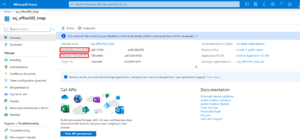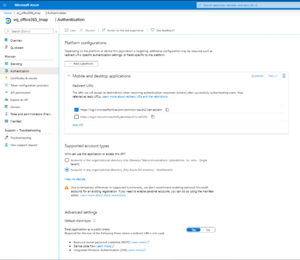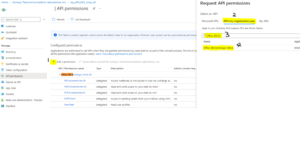password
Section: pop-client
Default Value: No default value
Valid Values: A valid password or refresh_token
Changes Take Effect: At the next POP cycle
Modified: 8.5.205.03
Specifies the password associated with this account for basic authentication and OAuth2 enabled (mail.[type].auth.mechanisms is XOAUTH2) for a Microsoft Azure mailbox.
You set this value during the E-mail Server setup.
For Gmail, if a mailbox is OAuth2 enabled (mail.[type].auth.mechanisms is XOAUTH2), this option is used for the refresh_token of the mailbox.
For Outlook, if the type is GRAPH or grant-type is client_credentials, this is used for the Azure application secret.
scope
Section: pop-client
Default Value: https://outlook.office.com/.default
Valid Values:
- The valid scope for Microsoft office 365 Graph API is https://graph.microsoft.com/.default
- The valid scope for Microsoft Office 365 is https://outlook.office.com/.default
Changes Take Effect: At the next POP cycle
Introduced: 8.5.107.06
Modified: 8.5.202.02, 8.5.205.03
Specifies the access token scope. This parameter takes effect only when the mail.<type>.auth.mechanisms is set to XOAUTH2 or type is GRAPH.
client-id
Section: pop-client
Default Value: No default value
Valid Values: A valid Client ID of the Microsoft Azure or Google application provided by the customer after the mailbox is registered in Microsoft Azure or Google
Changes Take Effect: At the next POP cycle
Introduced: 8.5.107.06
Modified: 8.5.201.05, 8.5.202.02, 8.5.205.03
Specifies the Client ID of the registered Microsoft Azure application for the Office 365 mailbox or the Google application for the Gmail mailbox in the corresponding POP client. This parameter takes effect only when the mail.<type>.auth.mechanisms is set to XOAUTH2 or type is GRAPH..
tenant-authority
Section: pop-client
Default Value: https://login.microsoftonline.com
Valid Values: The valid Microsoft authority server is https://login.microsoftonline.com. The valid Google authority server is a case-insensitive string that contains "google".
Changes Take Effect: At the next POP cycle
Introduced: 8.5.107.06
Modified: 8.5.201.05, 8.5.202.02, 8.5.205.03
Specifies the authority server of the registered Microsoft Azure application for the Office 365 or the Google application for the Gmail mailbox in the corresponding POP client. This parameter takes effect only when the mail.<type>.auth.mechanisms is set to XOAUTH2 or type is GRAPH.
directory-id
Section: pop-client
Default Value: No default value
Valid Values: A valid Microsoft Azure application Directory (tenant) ID provided by the customer after the mailbox is registered in Microsoft Azure
Changes Take Effect: At the next POP cycle
Introduced: 8.5.107.06
Modified: 8.5.202.02, 8.5.205.03
Specifies the Directory (tenant) ID of the registered Microsoft Azure application for the Office 365 mailbox in the corresponding POP client. This parameter takes effect only when the mail.<type>.auth.mechanisms is set to XOAUTH2 or type is GRAPH.
password
Section: pop-client
Default Value: No default value
Valid Values: A valid password or refresh_token
Changes Take Effect: At the next POP cycle
Modified: 8.5.205.03
Specifies the password associated with this account for basic authentication and OAuth2 enabled (mail.[type].auth.mechanisms is XOAUTH2) for a Microsoft Azure mailbox.
You set this value during the E-mail Server setup.
For Gmail, if a mailbox is OAuth2 enabled (mail.[type].auth.mechanisms is XOAUTH2), this option is used for the refresh_token of the mailbox.
For Outlook, if the type is GRAPH or grant-type is client_credentials, this is used for the Azure application secret.
token-expiry-margin-time
Section: smtp-client
Default Value: 00:00:10
Valid Values: Any less than one hour period in hh:mm:ss format
Changes Take Effect: See the description
Introduced: 8.5.107.06
Modified: 8.5.202.02
Specifies the amount of time an SMTP connection remains connected before its access token expires and the server closes the connection. This parameter takes effect only when the mail.<server-type>.auth.mechanisms is set to XOAUTH2.
scope
Section: smtp-client
Default Value: https://outlook.office.com/.default
Valid Values:
- The valid scope for Microsoft office 365 Graph API is https://graph.microsoft.com/.default
- The valid scope for Microsoft Office 365 is https://outlook.office.com/.default
Changes Take Effect: At start/restart
Introduced: 8.5.107.06
Modified: 8.5.205.03
Specifies the access token scope. This parameter takes effect only when the protocol type is EWS and mail.ews.auth.mechanisms is XOAUTH2 or type is GRAPH.
client-id
Section: smtp-client
Default Value: No default value
Valid Values: A valid Client ID of the Microsoft Azure or Google application provided by the customer after the mailbox is registered in Microsoft Azure or Google
Changes Take Effect: At start/restart
Introduced: 8.5.107.06
Modified: 8.5.201.05, 8.5.202.02, 8.5.205.03
Specifies the Client ID of the registered Microsoft Azure application for the Office 365 or the Google application for the Gmail account in the SMTP client. This parameter takes effect only when the mail.<server-type>.auth.mechanisms is set to XOAUTH2 or type is GRAPH.
tenant-authority
Section: smtp-client
Default Value: https://login.microsoftonline.com
Valid Values: The valid Microsoft authority server is https://login.microsoftonline.com. The valid Google authority server is a case-insensitive string that contains "google".
Changes Take Effect: At start/restart
Introduced: 8.5.107.06
Modified: 8.5.201.05, 8.5.202.02, 8.5.205.03
Specifies the authority server of the registered Microsoft Azure application for the Office 365 or the Google application for the Gmail SMTP account in the SMTP client. This parameter takes effect only when the mail.<server-type>.auth.mechanisms is set to XOAUTH2 or type is GRAPH.
directory-id
Section: smtp-client
Default Value: No default value
Valid Values: A valid Microsoft Azure application Directory (tenant) ID provided by the customer after the mailbox is registered in Microsoft Azure
Changes Take Effect: At start/restart
Introduced: 8.5.107.06
Modified: 8.5.202.02, 8.5.205.03
Specifies the Directory (tenant) ID of the registered Microsoft Azure application for the Office 365 mailbox in the SMTP client. This parameter takes effect only when the mail.<server-type>.auth.mechanisms is set to XOAUTH2 or type is GRAPH.
Setting up Microsoft Azure mailboxes for OAuth 2.0 authorization
Starting with version 8.5.107.06, E-mail Server supports the OAuth 2.0 authorization access to Microsoft Exchange Online API for Office 365 with the IMAP and EWS protocols. Starting with version 8.5.202.02, OAuth 2.0 support is extended to POP3 and SMTP protocols.
Starting with version 8.5.205.03, OAuth 2.0 support is extended to the Graph API with client secret only.
To set up Microsoft Azure mailboxes using the OAuth 2.0 authorization access:
Creating a Microsoft Azure application
Starting with version 8.5.205.03, E-Mail Server can support the Graph API with Client Credentials Grant Flow.
OAuth defines the following grant types: authorization code, implicit, resource owner password credentials, and client credentials. The Genesys solution uses resource owner password credentials.
- Follow Steps 1-8 as described in
this documentation to register an Azure public client application for the mailbox(es) that will be accessed by Genesys E-mail Server. Note that a single Azure application can support all mailboxes for the same company.
- Note: The Azure client application does not need to be public if it is for Graph.
- In step 6, for entering the name in Supported account types:
- Select Accounts in any organizational directory (Any Azure AD directory – Multitenant).
- Note: Single-tenant accounts, Accounts in this organizational directory only, are also supported.
- Leave the Redirect URI empty (as well as in Step 7).
- Select Accounts in any organizational directory (Any Azure AD directory – Multitenant).
- Copy and paste the Application (client) ID and the Directory (tenant) ID into a text document for insertion during the E-mail Server configuration.
After the application is created, it should look similar to this (click to expand it):
Where esj_office365_imap is the Azure application name.
If you open the Supported account types and Redirect URIs, it should look similar to this:
The Application ID URI should be empty:
Adding Application Permissions
Read through the article Permissions and consent in the Microsoft identity platform endpoint to learn about permissions and consent.
Graph
Set the application permissions for graph as given in this document Configure permissions for Microsoft Graph. Ensure that the application has the following application permissions with an admin consent grant:
We recommend to read through this document Limiting application permissions to specific Exchange Online mailboxes to learn how to limit app access to specific mailboxes.
Legacy protocols
For other protocols (EWS, IMAP, POP3, and SMTP), you might want to consult this document, Configure permissions for Microsoft Graph, although it focuses on getting permissions for the Graph API and you must configure application permissions for Office 365 Exchange Online.
For IMAP, POP3, and EWS, the application must have the following permissions granted by the company's administrator, depending on the email protocols used:
Since early 2020, Microsoft stopped exposing API permissions for IMAP, POP3, and SMTP under Office 365 Exchange Online, although it still supports those protocols and continues exposing the User.* and EWS.* permissions. Based on the article, Azure Active Directory app manifest, users can edit the Azure App manifest to configure an app’s attribute.
Users can manually edit the requiredResourceAccess attribute by adding IMAP.AccessAsUser.All, POP.AccessAsUser.All, and SMTP.Send. The following example shows the related part (requiredResourceAccess) in the manifest of an Azure app. The app has all 5 permissions. As Microsoft continues to expose the User.* and EWS.* permissions under Office 365 Exchange Online, users can add these two permissions in the Azure UI. The requiredResourceAccess attribute contains two items. Then, the user can manually add the items that represent IMAP.AccessAsUser.All, POP.AccessAsUser.All, and SMTP.Send under the same resourceAccess of the same resourceAppId. The ID values for IMAP.AccessAsUser.All and other protocols could be different for different apps. The Exchange Admin must find it out.
- For the EWS protocol, the Azure application must have the following permissions:
- User.Read
- EWS.AccessAsUser.All
- For the IMAP protocol, the Azure application must have the following permissions:
- User.Read
- IMAP.AccessAsUser.All
- For the POP3 protocol, the Azure application must have the following permissions:
- User.Read
- POP3.AccessAsUser.All
- For the SMTP protocol, the Azure application must have the following permissions:
- SMTP.Send
Setting up a mailbox
The mailboxes has the following special settings in the company’s system:
- Multifactor authentication is disabled on the mailboxes for the legacy protocols (POP3, IMAP, SMTP, and EWS).
- The IMAP protocol is enabled (if IMAP is used).
- The POP3 protocol is enabled (if POP3 is used).
- Nothing is needed for the EWS protocol.
Configuring Genesys E-mail Server
To configure E-mail Server:
- Set the JavaMail property mail.<type>.auth.mechanisms (where <type> can be ews, imap, pop3, or smtp) to XOAUTH2. (To disable OAuth 2.0, remove the JavaMail property.)
- Add this JavaMail property for a Microsoft Office 365/Outlook POP3 mailbox pop-client:
mail.pop3.auth.xoauth2.two.line.authentication.format=true
Configuring the smtp-client section
Configure the following configuration options:
- directory-id—Specify the Directory (tenant) ID of the registered Microsoft Azure application for the Office 365 mailbox.
- tenant-authority—Specify the authority server of the registered Microsoft Azure application for the Office 365 mailbox. For Office 365, the default configuration value is https://login.microsoftonline.com/.
- client-id—Specify the Client ID of the registered Microsoft Azure application for the Office 365 mailbox.
- scope—Specify the access token scope. For Office 365, the default configuration value is:
- https://outlook.office.com/.default for the legacy protocols (POP3, IMAP, SMTP, and, EWS).
- https://graph.microsoft.com/.default for the GRAPH protocol.
- token-expiry-margin-time— Specify the amount of time an SMTP connection for the EWS/SMTP type remains connected before its access token expires and the server closes the connection.
- password— If the type is Graph, this password is used for the Azure application secret.
Configuring the pop-client section
Configure the following configuration options:
- directory-id—Specify the Directory (tenant) ID of the registered Microsoft Azure application for the Office 365 mailbox in the corresponding POP client.
- tenant-authority—Specify the authority server of the registered Microsoft Azure application for the Office 365 mailbox in the corresponding POP client. For Office 365, the default configuration value is https://login.microsoftonline.com/.
- client-id—Specify the Client ID of the registered Microsoft Azure application for the Office 365 mailbox in the corresponding POP client.
- scope—Specify the access token scope. For Office 365, the default configuration value is:
- https://outlook.office.com/.default for the legacy protocols (POP3, IMAP, SMTP, and, EWS).
- https://graph.microsoft.com/.default for the GRAPH protocol.
- password— If the type is Graph, this password is used for the Azure application secret.
Configuring Proxy
E-mail Server implements Microsoft identity platform and OAuth 2.0 Resource Owner Password Credentials. It sends the client identification and user's credentials to the Microsoft Identity Platform (IDP) to request an access token. If a proxy has been used to access Office 365, you must have additional access to the Microsoft IDP (https://login.microsoftonline.com/, default https port is 443) and keep the same credentials if they were created previously.
To comply with RFC 6749, the Microsoft IDP validates the resource owner credentials by accessing the resource owner.






